|
PERSONNEL |
|
|
|
notable personnel of the 318th fis |
|
|
|
MajOR Clyde Falls |
|
|
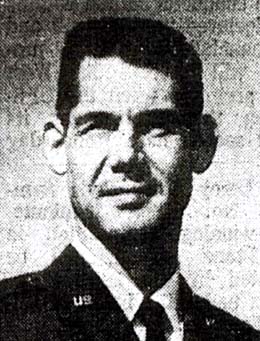 |
|
|
F-106 Pilot
(1968 - 1969) |
|
|
|
|
|
biography |
|
|
|
After his initial pilot training Major
Clyde L Falls Jr, served as a F-86D pilot with the 41st FIS
Andersen Air Force
Base, Guam from Sept 1958 to
March 1960. The 41st FIS provided air defense coverage for
units assigned to Anderson AB.
|
|
|
|
In mid 1960, Falls was reassigned to the 3640th Pilot
Training Wing's 3641 Student Squadron at Laredo AFB, TX where
he was an Academic Instructor in the Lockheed T-33 "T-Bird"
and Northrop T-38 Talon.
|
|
|
|
On 28 Nov 66 the then Capt Falls began conversion training in
the Republic F-105 Thunderchief with the 23rd Tactical Fighter
Wing, McConnell AFB KS. After F-105 training, he arrived at
Korat AB, Thailand
on 6 July 1967 and was assigned to the 34th Tactical Fighter
Squadron, 366th Tactical Fighter Wing.
|
|
|
|
After flying his 100 mission in Southeast Asia in the F-105 on
March of 1968, Maj Falls was reassigned to the 318th Fighter
Interceptor Squadron at McChord AFB, WA flying the Convair
F-106 Delta Dart interceptor.
|
|
|
|
On 22 April 1969, Maj Falls died when his F-106 crashed
into a mountain near Eatonville in
Washington State.
|
|
|
|
The recipient of four Distinguished Flying Crosses and 15 air
metals was awarded the Silver Star in November of 1968 for his
heroic efforts in combat in Southeast Asia.
|
|
|
|
|
|
F-105 PILOT - 34th TFS |
|
|
 |
|
|
F-106 Pilot
(1968 - 1969) |
|
|
 |
|
|
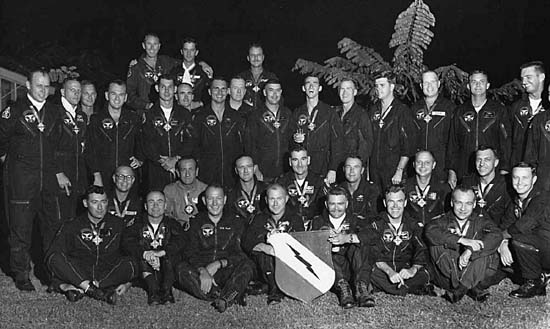 |
|
picture from 34th Tactical Fighter Squadron "Thud Era"
34tfsthuds.us/ |
|
The 34th Tactical Fighter Squadron in October 1967 -
Front row sitting L to R:
Robert Elliott, Ken Mays, Col. James Bean, George Clausen, Rod
Giffin, William King & Billy Givens.
Middle row kneeling: Bill Blakslee, Col.
John Flynn, David Dickson, Lt Col. Mervin Taylor, Lt
Col. Robert Smith, Raymond Vissotsky, Donald Revers, &
Vernon Ellis. Middle row standing:
Floyd Heinzig, Larry Hoppe, ? Zimmerman, James Daniel, Clyde
Falls, Jake Schuler, Spence Armstrong, LtC ol. William Evans,
David Ingleman, David Waldrop, Donald Hodge, Sam Morgan, Robert
Crane, Almer Barner, Douglas Beyer, & James
Taylor.Back row: Lawrence Klinestiver,
Hugh Davis & Dalton Leftwich.
|
|
|
 |
|
|
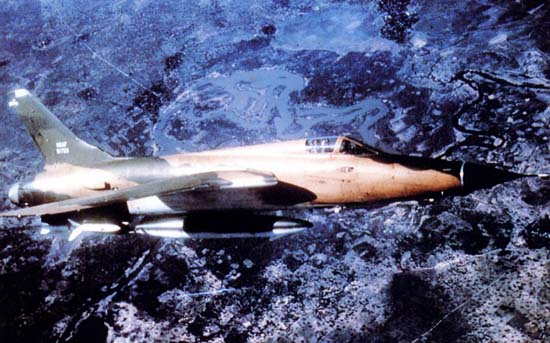 |
|
PHOTO FROM "ROLL CALL THUD" BY JOHN CAMPBELL & MICHAEL HILL |
|
F-105D 59-1759 assigned to the 34th TFS was the aircraft flown by
Maj Falls during a mission flown with the 469th TFS on 01 Dec 1967.
Pilots during this mission Laos, were nominated for 1 Air Force Cross, 5
Silver Stars, 26 Distinguished Flying Crosses, and 38 Air Metals.
|
|
|
|
|
|
SILVER STAR RECIPIENT |
|
|
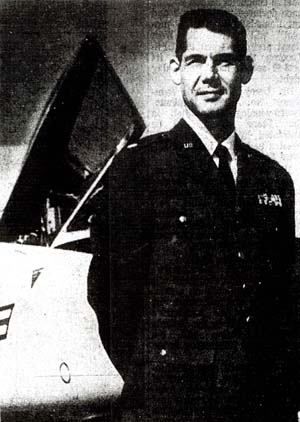 |
Maj Clyde Falls stands near a McChord
based F-106 in
1968 |
|
|
|
|
|
Decorated at McChord
for Heroism
|
|
Fighter-Bomber Pilot Gets a Chest-Full of Metals
|
|
By Al Gibbs - Tacoma News Tribune - -
Sunday, November 3, 1968
|
|
|
|
McCHORD AIR FORCE BASE - A fighter-bomber pilot who got a
little irritated when North Vietnamese gunners shot holes in
his airplane received a chest-full of metals here last week.
Air Force Maj. Clyde L. Falls Jr. was presented the Silver
Star, four Distinguished Flying Crosses and 15 Air metals.
|
|
|
|
The Silver Star, the Nations' third highest award for
combat heroism, was presented for the major's actions during a
raid on the Kep airfield northeast Hanoi. Maj Falls, 35, who
calls Vancouver, Wash., home, was credit with knocking out two
antiaircraft gun emplacements even though his F-105 jet had
been hit.
|
|
14 Year Veteran
|
|
|
|
"You have to find the gun sites to hit and that means
waiting they fire at you," the 14-year veteran explained in an
interview.
|
|
|
|
"When I saw them firing, I dove on the position.
About the time, I saw the flak explode in front of me and hit
the plane. "It irritated me a little bit." Maj Falls continued
the attack with flak holes in the metal skin and plexiglas
windshield of his jet. It was one of the three times his plane
was on fire during missions over North Vietnam.
|
|
Citations for the other metals credit the major with
destroying two Communist MiG fighters during a raid on Phuc
Yen airfield, the most heavily defended base in North Vietnam,
despite the fact that his plane was on fire during the attack;
with destroying an enemy barracks; with a successful attacks
on a railway yard and railroad bridge; and with making a
successful attack, then returning in an attempt to rescue a
downed pilot. The official words on the orders are impersonal.
Maj Falls ' recollections are not.
|
|
|
|
"Coming into the target they throw up the SAMs at
you," he said.
|
|
SAMs are surface-to-air missiles, which are
electronically guided and have an effective exploding range of
more than 500 yards. The major remembers several close calls
with the missiles, including one in which his wingman was shot
down by a SAM.
|
|
"You only have a couple of seconds to move away and
hope they miss," he said. "When the SAMs start coming up at
you, things get a little tense." The enemy MiG fighters bother
the pilots too.
|
|
"Going in on target you have to look down and
concentrate on the target and the ground fire. You haven't got
time to be looking up for MiGs too, you just have to keep them
out of your mind until you've made the attack and are coming
off the target."
|
|
Although he was shot at by MiGs during the raids,
Maj. Falls said aerial dogfights are not common.
|
|
"The MiGs generally won't come down where we fly
because the F-105 is a better plane at that altitude, though
he said, "after all," the major said, "our job was the bomb,
not shoot down MiGs. If we had a chance at one, fine, but we
generally didn't go looking for them."
|
|
During his duty at Korat Air Base, Thailand, Maj
Falls flew nearly 20 missions a month. The pilots were allowed
a week's rest every month.
|
|
Pressure Builds
|
|
|
|
"The pressure builds during the flights," he said,
"but a lot of us got more nervous toward the end of the rest
periods wondering how the other pilots were doing."
|
|
For the pilot new to the North Vietnam raids, the
pressure of a mission begins to build long before the takeoff
from Thailand and the long flight to the target. "We put all
of the new pilots on at least five missions just above the DMZ
before they went further north," he said. "Those southern
raids are a piece of cake but they're good experience,"
|
|
Raids against bases in the north, especially near
Hanoi and Haiphong, are made through some of the heaviest and
most concentrated anti-aircraft fire in Air Force history.
"After you've been at it for a while, the tension doesn't
start to hit you until after you've left the (refueling)
tanker and get into bad-guy country."
|
|
Become a Target
|
|
|
|
"Then you become a target if you're part of a protection
force." This flight generally flies into an area immediately
before the main strike force to knock out anti-aircraft sites.
"It's a pretty simple technique, really," Maj. Falls grinned,
"You put yourself out as bait and let them shoot at you then
you shoot back when you know where the target is."
|
|
|
|
Nearly 50 pilots were shot down during the major's tour
with one fighter-bomber wing there.
|
|
|
|
Now he flies the F-106 jet interceptor with the 318th
Fighter-Interceptor Squadron at McChord, and nobody is
shooting at him. The Major is planning a three-year assignment
here away from flak and missiles and MiGs.
|
|
|
|
"The insurance rates are a lot better, he grinned.
|
|
|
|
|
|
THE CRASH OF MAJ FALLS |
|
|
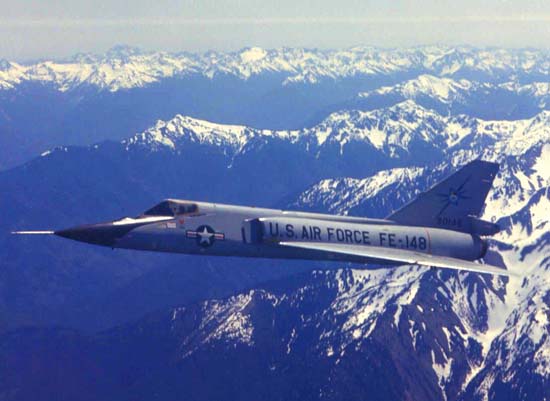 |
|
PHOTO FROM "Erv Smalley's & Marty Isham's Convair
F-106 Delta Dart"
www.convairf-106deltadart.com/
|
|
The aircraft involved in the crash, s/n 59-0148 was the last of 340
F-106's built for the USAF, it was accepted in November of 1960, and
delivered to its first squadron, the 456th FIS on 07 February 1961. The
F-106 arrived at McChord on 22 May 1963.
|
|
|
|
|
|
FATAL IRONY RECALLED Pilot was Survivor of
many a Skirmish.
|
|
By Al Gibbs - Tacoma News Tribune - -
Wednesday - 23 April 1969
|
|
|
|
McCHORD AIR FORCE BASE - Last
November, the statement made since. "The insurance rates are a
lot better here," Maj. Clyde L. Falls said grinning.
|
|
|
|
The Major had survived a year
of fighter bomber strikes against North Vietnamese bases and
had settled down to a comfortable three-year tour flying F-106
jet interceptors here (at McChord). Tuesday, Maj Clyde L.
Falls Jr. died when his Delta Dart crashed into a mountain
near Eatonville and his comment made during an interview with
this reporter, became fatal irony.
|
|
|
|
MUCH DECORATED
|
|
|
|
Maj Falls was relaxed last
November. He just received the Silver Star, the nation's third
highest award for combat valor, and 4 Distinguish Flying
Crosses, and 15 Air Metals. In a month or so, he would be
married.
|
|
|
|
The metals earned dodging flak
and missiles and Communist MiG jets during raids against bases
deep in North Vietnam. Most missions he flew as a part of a
strike protection force charged with knocking out
anti-aircraft batteries in advance of the main bombing group.
|
|
|
|
"It's a pretty simple
technique really" Falls said at the time "You put yourself out
as bait and let them shoot at you. When you shoot back, you
know where the target is."
|
|
|
|
Nearly 50 fellow pilots from
Falls' wing were shot down during his tour
|
|
|
|
FLAK 'IRRITATED'
|
|
|
|
On one raid, exploding flak
peppered his F-105 jet. "It irritated me a little bit," he
said.
|
|
|
|
Maj Falls continued to attack
the target, however, with flak holes in the metal skin and
plexiglass windshield of his jet. His plane was damaged twice
more during the raids. He was credited with knocking out two
antiaircraft batteries despite the damage. He destroyed two
MiGs (on the ground) and enemy barracks, and heavily damaged a
railway yard and railroad bridge.
|
|
HELP FOR A BUDDY
|
|
|
|
On one mission he made his
attack then returned to help a downed American pilot.
|
|
|
|
The Major was the fourth
McChord fighter pilot to die in crashes in the past 1 1/2
years. Last April, two officers (Col. Wilfred B. Crutchfield
and Lt. Col. Ivan E. O’Dell) were killed when their jet (T-33A
s/n 56-3664) crashed into the side of Mt. Rainier. And in
October 1967, an F-106 pilot (Maj Richard S. Petersen in F-106
s/n 59-0022) died in a crash near Raymond.
|
|
|
|
The Air Force will convene an
accident review board to investigate Falls' crash to discover
why the survivor of a year enemy fire crashed when nobody was
shooting.
|
|
|
|
|
 |